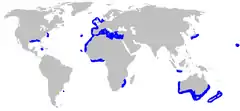| Dalatias licha[1] | |||||
| Bonnaterre, 1788[2] | |||||
 | |||||
| Systematyka | |||||
| Domena | |||||
|---|---|---|---|---|---|
| Królestwo | |||||
| Typ | |||||
| Podtyp | |||||
| Gromada | |||||
| Podgromada | |||||
| Rząd | |||||
| Rodzina | |||||
| Rodzaj |
Dalatias | ||||
| Gatunek |
liksa | ||||
| |||||
| Kategoria zagrożenia (CKGZ)[18] | |||||
 | |||||
| Zasięg występowania | |||||
 | |||||

Liksa[19] (Dalatias licha) – gatunek rekina z rzędu koleniokształtnych w rodzinie scymnowatych, będący jedynym przedstawicielem swojego rodzaju. Liksa jest znajdywana sporadycznie na świecie, zazwyczaj przy dnie mórz na głębokościach 200-600 m. Wraz ze sporą wątrobą dla utrzymania naturalnej pływalności, rekin ten potrafi płynąć w wodzie zużywając niewielką ilość energii. Liksa posiada smukłe ciało z bardzo krótkim, tępym ryjem, dużymi oczami i grubymi wargami. Zęby są bardzo zróżnicowane pomiędzy górnymi, a dolnymi szczękami — górne zęby niewielkie i wąskie, a dolne zęby duże, trójkątne i ząbkowane. Typowa długość tego rekina waha się pomiędzy od 1 a 1,4 metra.
Systematyka i taksonomia
Liksa oryginalnie została opisana jako Squalus licha przez francuskiego przyrodnika Pierre'a Josepha Bonnaterre’a w jego Tableau encyclopédique et méthodique des trois regnes de la nature z 1788 roku; typ nomenklatoryczny z „Le cap Breton” został od wtedy odrzucony. Ten gatunek został później umieszczony w jego własnym rodzaju, Dalatias, którego nazwa pochodziła od synonimu nazwy pracy naukowej Constantine'a Samuela Rafinesque-Schmaltza z 1810 roku - Dalatias sparophagus i S. licha. Jednakże, niektóre organy zaprzeczają tym określeniom, uzasadniając, że D. sparophagus jest nomen dubium i wolą używać kolejnej dostępnej nazwy rodzaju, Scymnorhinus[20]. Nazwa rodzaju Dalatias pochodzi od greckiego dalos lub dalou, to znaczy „pochodnia”[21]. Nazwa gatunkowa, licha, pochodzi od la liche, francuskiej nazwy tego rekina[2].
Przypisy
- ↑ Dalatias licha, [w:] Integrated Taxonomic Information System (ang.).
- 1 2 3 J.P. Bonnaterre: Tableau encyclopédique et méthodique des trois regnes de la nature, Dédié et présenté a M. Necker, Ministre d’Etat, & Directeur Général des Finances. Ichthyologie. Paris: Chez Panckoucke, 1788, s. 12. (fr.).
- 1 2 C.S. Rafinesque: Caratteri di alcuni nuovi generi e nuove specie di animali e piante della Sicilia: con varie osservazioni sopra i medesimi. Palermo: Per le stampe di Sanfilippo, 1810, s. 10. (wł.).
- ↑ G. Cuvier: Le règne animal distribué d’après son organisation, pour servir de base a l’histoire naturelle des animaux et d’introduction a l’anatomie comparée. T. 2. Paris: Chez Déterville, s. 130. (fr.).
- ↑ S.D. Wood. The fishes (Pisces) of Britain, systematically arranged. „The Analyst; a Quarterly Journal of Science, Literature, Natural History, and the Fine Arts”. 5 (18), s. 214, 1837. (ang.).
- ↑ A. Valenciennes: Les poissons. W: G. Cuvier: Le règne animal distribué d’après son organisation, pour servir de base à l’histoire naturelle des animaux et d’introduction à l’anatomie comparée. Cz. 4: Atlas. Paris: Fortin, Masson et cie, 1836–1849, s. opis do ryciny 115. (fr.).
- 1 2 Ch.L. Bonaparte. Catalogo metodico dei pesci europei. „Atti della Settima Adunanza degli Scienziati Italiani Sesta Riunione”. 7 (2), s. 16, 1846. (wł.).
- ↑ J. von N.F.X. Gistel: Naturgeschichte des Thierreichs für höhere Schulen. Sttutgart: Hoffmann, 1848, s. x. (niem.).
- 1 2 A.W.Ch.T. Herre. Notes on fishes in the Zoological Museum of Stanford University. II. Two new genera and species of Japanese sharks and a Japanese species of Narcetes. „Copeia”. 1935 (3), s. 124, 1935. DOI: 10.2307/1436546. (ang.).
- ↑ J.F. Gmelin: Systema naturae per regna tria naturae: secundum classes, ordines, genera, species, cum characteribus, differentiis, synonymis, locis. T. 1. Cz. 3. Lipsiae: Impensis Georg. Emanuel. Beer., 1789, s. 1503. (łac.).
- ↑ A. Risso: Ichthyologie de Nice, ou histoire naturelle des poissons du Département des Alpes Maritimes. Paris: F. Schoell, 1810, s. 43, ryc. iv (rys. 6). (fr.).
- ↑ H. Cloquet: Dictionnaire des sciences naturelles, dans lequel on traite méthodiquement des différens êtres de la nature, considérés soit en eux-mêmes, d’après l’état actuel de nos connoissances, soit relativement à l’utilité qu'en peuvent retirer la médecine, l’agriculture, le commerce et les artes. T. 25. Strasbourg; Paris: F. G. Levrault; Le Normant, 1822, s. 433. (fr.).
- ↑ F.S. Voigt: Das Thierreich, geordnet nach seiner Organisation: als Grundlage der Naturgeschichte der Thiere und Einleitung in die vergleichende Anatomie. Cz. 2. Leipzig: F.A. Brockhaus, 1832, s. 512. (niem.).
- ↑ G.J. Billberg. Om ichthyologien och beskrifning öfver några nya fiskarter af samkäksslägtet Syngnathus. „Linnéska Samfundets Handlingar”. 1 (för år 1832), s. 52, 1833. (szw.).
- ↑ G.P. Whitley. New names for Australian fishes. „The Australian Zoologist”. 6 (4), s. 310, 1931. (ang.).
- ↑ J.L.B. Smith. Two interesting new fishes from South Africa. „Transactions of the Royal Society of South Africa”. 24 (1), s. 1, ryc. 1–2, 1936. DOI: 10.1080/00359193609518910. (ang.).
- ↑ S.-C. Shen & W.-H. Ting. Ecological and morphological study on fish-fauna from the waters around Taiwan and its adjacent islands. 2. Notes on some rare continental shelf fishes and description of two new species. „Bulletin of the Institute of Zoology Academia Sinica”. 11 (1), s. 18, rys. 3, 1970. (ang.).
- ↑ Dalatias licha, [w:] The IUCN Red List of Threatened Species (ang.).
- ↑ Eugeniusz Grabda, Tomasz Heese: Polskie nazewnictwo popularne krągłouste i ryby – Cyclostomata et Pisces. Koszalin: Wyższa Szkoła Inżynierska w Koszalinie, 1991.
- ↑ Compagno, L.J.V.: Sharks of the World: An Annotated and Illustrated Catalogue of Shark Species Known to Date. Rzym: Food and Agricultural Organization, 1984, s. 63-64. ISBN 92-5-101384-5.
- ↑ Froese, Rainer and Pauly, Daniel, eds. (2009). Dalatias licha w FishBase.